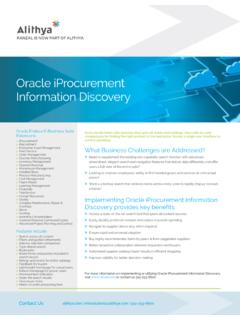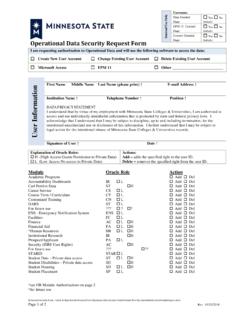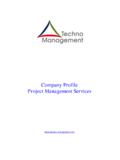Transcription of FDMEE vs. Cloud Data Management - Edgewater …
1 Recognized by ORACLE. Trusted by Customers. FDMEE vs. Cloud data Management Finding the Right data Integration Toolset for Cloud and Hybrid EPM Deployments data Governance Executive Summary As more organizations begin to embrace the Oracle software as a service (SaaS) of Enterprise Performance Management (EPM) Cloud offerings, there is an often overlooked but important decision that needs to be made early in the adoption cycle - what toolset will be used to integrate data into the EPM Cloud Service products such as Planning and Budgeting Cloud Service (PBCS), Financial Close and Consolidation Cloud Service (FCCS), or Profitability and Cost Management Cloud Service (PCMCS). This white paper explores the two primary data integration options that are available to customers and outlines the pros and cons of each. The conclusion provides a recommendation that can be applied to organizations of all industries and sizes as they plan their journey into the Cloud .
2 The Challenge Oracle continues to grow its Cloud service offerings both in terms of customer volume and functionality. The changing landscape of software and infrastructure has incented a number of organizations to adopt a Cloud strategy for one or more business processes. The benefits of the Cloud are undeniable the software is consistently enriched, the hardware is owned and maintained by Oracle, and application upgrades are touted as a thing of the past. While the shift to the Cloud is a broad topic with many considerations, the focus of this white paper is the data integration toolset, and more broadly, the integration strategy. As customers transition to the Cloud , they are often informed that the Cloud service includes a component called Cloud data Management (CDM) which can address all of the data integration needs for the Cloud service. Frankly, this is an overly optimistic view of the capabilities of Cloud data Management .
3 data integration requirements can drive solutions that range from very simple to incredibly complex, and this large spectrum demands a more holistic assessment of the integration options. While it is often unrealistic to evaluate the detailed solution (not just integration) requirements in a software sales cycle, the key question that every organization should have when considering their data integration strategy for EPM. Cloud Services is what are my options? Cloud Service data Integration Options As with any software offering, there are myriad potential solutions to a given need. When evaluating software options, choices are generally grouped into two categories buy versus build. A buy decision is purchasing a packaged software offering. The Oracle EPM Cloud Services are an example of a buy decision. In addition to prebuilt functionality, a key benefit of a packaged offering is support for the solution including future version releases.
4 2. data Governance A build decision means creating a custom solution (utilizing the various available toolsets) that is specific to a single organization. The latter is generally unsupported by a software vendor, and functionality and upgradability are both subject to the skillset of the individual or team that developed the solution. This white paper focuses on packaged (buy) solutions because they more closely align with the often-expressed goal of adopting a Cloud strategy simplifying the solution and its ownership. While options such as Oracle data Integrator (ODI), Groovy, or the REST API are all valid, these are considered build options in the build versus buy decision and thereby are excluded from this analysis. In terms of packaged offerings for integration with Oracle EPM Cloud Services, the two primary options available to customers are Financial data Quality Management , Enterprise Edition ( FDMEE ) and Cloud data Management .
5 FDMEE is a standalone on-premises solution while Cloud data Management is an integrated component within each of the Oracle EPM Cloud Services. Before comparing these products, it is necessary to highlight the purpose and capabilities of each. A final note about this white paper there are a wide range of companies and system capabilities in each that need to be considered in this analysis. This paper is not intended to address every permutation but instead focus on decision points which apply most broadly. What is FDMEE ? Financial data Quality Management , Enterprise Edition ( FDMEE ) is a purpose-built application for integrating data into the Oracle EPM suite of products. The application includes predefined logic for loading data to the on-premises EPM applications of Hyperion Financial Management (HFM), Account Reconciliation Manager (ARM), Hyperion Planning, and Essbase.
6 Additionally, FDMEE (as of the release) can integrate data directly to the EPM. Cloud Services of FCCS, PBCS, PCMCS, and Enterprise Planning and Budgeting Cloud Service (EPBCS). Additional EPM Cloud Services will undoubtedly be added to the out-of-the-box integrations that FDMEE will support through additional Patch Set Updates (PSU). FDMEE can loosely be defined as an ETL-like application. ETL is the integration process for extracting, transforming and loading data . FDMEE is not a true ETL tool because it is not intended to handle the extremely large volumes of data (millions of records in a single execution) for which a pure ETL tool such as Informatica or Oracle data Integrator (ODI) would potentially be a better fit. That said, FDMEE provides much of the same core functionality as ETL tools with the ability to extract data from a variety of sources, transform the data to the EPM dimensionality, and load the resulting data to EPM applications.
7 FDMEE is different than pure ETL in that FDMEE was designed with the business user in mind. ETL solutions are generally owned and operated by the IT department. ETL executions are scheduled, and any deviation from the defined process or timeline often requires coordination between the business user requesting the off-cycle execution and the IT owner of the ETL solution. 3. data Governance FDMEE by contrast is often administered and maintained by business users. FDMEE users have the ability to update transformation logic through an easy-to-use web interface with little to no coding knowledge needed. Users can schedule FDMEE jobs or execute them in an ad hoc fashion as data is needed or becomes available. The end- to-end process is completely within the hands of the business users. FDMEE provides robust and powerful extract capabilities including prebuilt adaptors to source data from Oracle E- Business Suite General Ledger, Fusion General Ledger, PeopleSoft General Ledger as well as Human Capital Management (HCM), Edwards EnterpriseOne General Ledger, SAP General Ledger, Business Warehouse (BW), and HANA.
8 These adaptors provide the logic and coding needed to source data and eliminate the need for organizations to define and maintain custom extract queries. This is a significant value-add of FDMEE . Additionally, FDMEE can source data from any relational repository as well as any flat file format. These three methods prebuilt adaptors, relational connection, and flat files ensure that FDMEE is able to consume nearly any data source required to support the EPM systems to which it is intended to load data . The transformation capabilities also known as mapping - are another key differentiator for FDMEE . Often the transformation that occurs during a standard ETL process is accomplished through SQL queries that must be designed from scratch. While FDMEE uses SQL to perform transformation in the background, the mapping logic is input in a web interface that looks and feels very much like an Excel worksheet.
9 Source system values are aligned to target system values in a columnar grid format. FDMEE maps support multiple mapping techniques including Explicit (One to One), Between (continuous range mapping to a single value), In (non-continuous range mapping to a single value), Like (wildcards), and even multi-dimensional maps where multiple source system segments are used to identify an EPM target dimension value. FDMEE further differentiates itself from standard ETL solutions in its load processes. The load process is purpose- built for integration into the Oracle EPM product suite. Not only does this ensure a seamless load of data to the target EPM application, but more so it includes prebuilt logic that enriches the data load process. For example, without any additional build effort, FDMEE can execute calculations in the target EPM application to perform things such as data clearing, currency translation, or aggregation.
10 While standard ETL tools can certainly achieve this, FDMEE offers this capability natively and requires no additional build effort outside of configuring the integration to execute these actions. FDMEE Value-Add Features The above highlights how FDMEE is similar to traditional ETL with some features being more robust ( , preconfigured inbound and outbound integrations) and others being less so ( , data volumes). There are out-of- the-box features of FDMEE that offer additional differentiation relative to traditional ETL. Because FDMEE stores its transformation logic within the application, users are able to investigate the data transformation that was applied to better understand how a source system data point was transformed to a target system intersection. Moreover, FDMEE has the ability to track changes to the transformation logic. It can track who the user was and when he or she changed the transformation logic.









